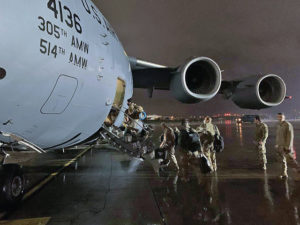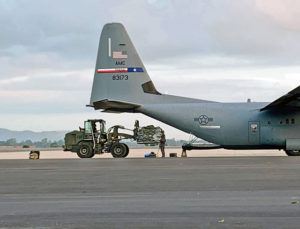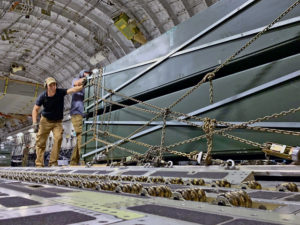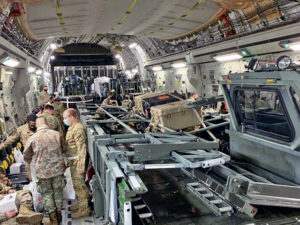
Several units from the 435th Air Ground Operations Wing recently rapidly deployed to Somalia at the direction of the President of the United States and the acting Secretary of Defense to reposition assets and personnel to other locations within East Africa in support of Operation Octave Quartz.
During the operation, U.S. Air Force Airmen from the 435th AGOW conducted over 300 airlift sorties to reposition 3,364 tons of equipment and 1,279 personnel quickly.
“I am extremely proud of both wings for how quickly and safely they accomplished an incredibly challenging mission with professionalism and tenacity,” said Col. Daniel C. Clayton, 435th Air Ground Operations Wing and 435th Air Expeditionary Wing commander. “Once again, our amazing Airmen across Africa and Europe proved their readiness and resiliency, by rapidly responding and effectively executing their mission in the austere conditions and contested environment of East Africa.”
In total, Joint Task Force – Quartz and supporting units flew more than 1,000 sorties using 17 different types of aircraft, moved 4.6 million pounds of cargo, and repositioned hundreds of personnel throughout East Africa in less than two months.

“We continue to support our partners in their fight against violent extremists like al-Qaeda affiliate as-Shabaab and ISIS-Somalia who aim to destabilize the region, attack civilians, and target the U.S.,” said Maj. Gen. Dagvin Anderson, Joint Task Force – Quartz commander. “We conducted five strikes against al-Shabaab, even while repositioning forces, showing that we remain committed to keeping pressure on al-Shabaab and supporting our partners who do the same.”
Approximately 75 Airmen from the 435th AGOW assigned to the 435th Contingency Response Group, 435th Air and Space Communications Group, and 4th Air Support Operations Ground provided support to the mission.
“The objective of OOQ was to reposition U.S. Department of Defense forces in Somalia to other East African operating locations while enabling joint and coalition partners to maintain pressure on violent extremist organizations,” said Lt Col Sean McCurdy, 435th CRG commander.
The 435th CRG provides scalable, cross-functional, and rapidly deployable forces designed to assess and open airbases in order to perform initial airfield operations, enabling rapid stand-up of combat operations anywhere in their area of responsibility.
“The 435th AGOW deployed a team of multifunctional contingency response and communications Airmen to enable the rapid repositioning,” McCurdy said. “Specifically, the primary role of the team at each location was to integrate with the base command teams, increase the capacity to support airlift operations, and lead the expedited processing, upload and download of cargo and passengers on C-130J Super Hercules aircraft.”

As the only U.S. Air Force contingency response unit in U.S. Air Forces in Europe – Air Forces Africa, the Airmen assigned to the 435th AEW and 435th AGOW provide airlift flexibility to the U.S. military’s posture in the continued fight against violent extremism.
“This operation allowed the CRG to show our agility,” said McCurdy. “Our contingency response teams contain highly trained multifunctional Airmen, which allows us to maintain capability while reducing our footprint. This made us lighter and leaner, and provided the flexibility to rapidly respond to the point of need throughout the area of responsibility.”
The 1st Combat Communi-cations Squadron, which is a part of the 435th ACOMG, supported the 435th CRG by maintaining constant communication capabilities.
“We provided the 435th CRG with small communications packages which were easily maneuverable in the light and lean tactical environment,” said Capt Kayla Haven, 1st CBCS assistant director of operations. “1st CBCS personnel also assisted the 435th CRG with packing and loading aircraft with equipment.”
Haven served as the communication liaison officer and director of staff for the Joint Air Component Coordination Element, during OOQ. The JACCE coordinated air operations and maintained communications and awareness between the Ramstein Combined Air Operations Center and the Joint Task Force commander.

“The JACCE acted as a Forward Air Operations Center,” said Haven. “Essentially, all airspace movements, including aircraft going into theater to pick up the equipment and personnel, were coordinated through the JACCE.”
In addition to 435th CRG and 435th ACOMG support, the 2nd Air Support Operations Squadron, which is a part of the 4th ASOG, provided capabilities to the ground commander through employment of Tactical Air Control Parties.
“Airmen from the 2nd ASOS deployed to the 435th Air Expeditionary Wing to provide TACP expertise and Joint Terminal Attack Controllers in support of the U.S. Army’s 173rd Infantry Brigade Combat Team,” said Maj. Seth G. Ostlund 2nd ASOS director of operations. “We rapidly deployed our Airmen to serve as part of the Quick Reaction Force in order to bolster the overall land-based security package for the operation.”
This complex logistics and security operation was accomplished while maintaining significant pressure against al-Shabaab. U.S. forces will continue to support partner forces in Somalia and throughout the region while also surveilling and striking violent extremists.
“Any large-scale movement of forces or equipment presents an operational vulnerability,” Ostlund said. “Our unit’s contribution was toward reducing that vulnerability by posturing as additional security.”
435th AEW and 435th AGOW Airmen are poised to support at any time with mission-ready contingency forces.
“This mission showcases the proficiency of the contingency response forces and the capabilities they bring to the joint force, despite their smaller size,” said McCurdy. “More importantly, it serves as a powerful model for larger organizations as they seek to develop Agile Combat Employment concepts going into the future.”
The joint task force safely and expeditiously moved all U.S. personnel and equipment to their destination ahead of schedule.
“The speed in which this operation was developed and successfully implemented demonstrates the ability of USAFE to rapidly plan, coordinate, and reposition forces from one geographic command to another, and then back again,” said Ostlund.


